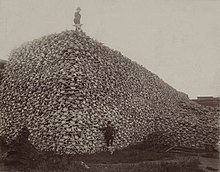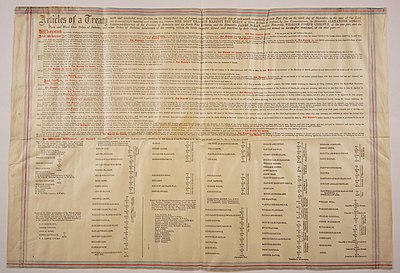Treaty 6
On 6 July 2012, the City of Edmonton, represented by Mayor Stephen Mandel, signed a partnership agreement with the Confederacy.The grand chief is the primary spokesperson for the Confederacy in the media and represents the member nations in certain political fora.Signatories included Alexander Morris, Lieutenant Governor of the North-West Territories, James McKay, Manitoba's Minister of Agriculture, and W.J.By 1871, the Indigenous peoples from the northern plains of the North-West Territories (NWT), the Cree, Ojibwa and Assiniboine, considered negotiating a treaty with the government to protect their traditional lands from settlers and HBC surveyors.[11] By the 1870s, the population of the once-plentiful bison had decreased to the point that tribal chiefs, elders, and many of the people sought the Crown's protection to ward off starvation.[13][14] Considering the sale of the NWT to Canada from the HBC, the Indigenous peoples were concerned about entering into a treaty with the Canadian government as they did not want their land to be taken over.[11] According to the settler version of history and the terms of treaty making, First Nations gave up their customary title to the land under common law in exchange for provisions from the government.The First Nations understanding is radically different from the British version; in the oral histories, translations (for example there is no concept of "land ownership" or "cede", which follows from the concept of land ownership, in the Cree language[dubious – discuss]), and British customs, there continues to be controversy as to possible different understandings of the terms as they were used at the time of the treaty signings.The Plain and Wood Cree Tribes of Indians, and all other the Indians inhabiting the district hereinafter described and defined, do hereby cede, release, surrender and yield up to the Government of the Dominion of Canada, for Her Majesty the Queen and Her successors forever, all their rights, titles and privileges, whatsoever, to the lands included within the following limits...[20]During the treaty negotiations, the Indigenous peoples requested for agricultural tools, animals such as an ox and a cow for each family, assistance for the poor and those unable to work, the ban of alcohol in the province of Saskatchewan, and education to be provided for each reserve.In addition, the Indigenous peoples asked to be able to change the location of their settlement before the land was surveyed, ability to take resources from Crown lands such as timber, cooking stoves, medicine, a hand mill, access to bridges, and in the event of war the ability to refuse to serve.[21] In exchange, for Indigenous lands, the federal government agreed to set up certain areas as "reserves" (i.e. protected from encroachment by white settlers).A maximum of four chiefs and other officers per band would receive $15 each and a salary of $25 per year plus one horse, one harness, and one wagon[24] or two carts.The Indigenous peoples also received a $1500 grant every year to spend on ammunition and twine in order to make fish nets.As well, each family was to be given an entire suite of agricultural tools including spades, harrows, scythes, whetstones, hay forks, reaping hooks, ploughs, axes, hoes, and several bags of seed.[27] Although there were three interpreters presents at the negotiations for Treaty 6, two from the Crown and one from the Indigenous peoples, direct translation of words between English and Cree was not possible.[29] Another understanding was that the Indigenous peoples could choose the amount of land they wanted to retain, but surveyors came to set per person perimeters on the reserves which was seen as a violation of the treaty.The "medicine chest clause" has been interpreted by native leaders to mean that the federal government has an obligation to provide all forms of healthcare to First Nations people on an ongoing basis.





Fort CarltonFort PittIndigenous peoplesin CanadaFirst NationsMétisTimelinePre-colonizationGeneticsSettler colonialismGenocideResidential schoolsIndian hospitalsReconciliationIndigenous lawBritish Columbia Treaty ProcessCrown and Indigenous peoplesHealth PolicyIdle No MoreIndian ActIndigenous and Northern Affairs CanadaLand BackLand claimsLand defenderLand titleMissing and Murdered Indigenous WomenNumbered TreatiesRoyal CommissionSelf-governmentSpecific claimsTreaty rightsIndigenous personalitiesCountry foodIndian reservesTerritoriesPacific CoastInuit languagesChinuk WawaIndigenous English DialectsAboriginal syllabicsChinuk pipaInuit grammarTraditional beliefsInuit religionIndex of articlesCanadian CrownAssiniboineband governmentsAlexander MorrisJames McKayWilliam J. ChristieMistawasisAhtahkakoopSaskatchewanAlbertaMontreal LakeEdmontonSaskatoonMorinvilleLloydminsterCity of EdmontonStephen Mandelpremier of AlbertaEnoch Cree NationMontana First NationAlexander First NationKehewin Cree NationWilliam (Billy) MorinWilton Littlechildmember of parliamentTruth and Reconciliation Commission of CanadaErmineskin Cree NationCold Lake First NationsDetroitLieutenant Governor of the North-West TerritoriesManitobaHudson's Bay CompanyColonel James WalkerAmerican bison or buffaloAmerican frontierbison huntingPlains Indiansgreat bison beltNorth-West TerritoriesOjibwatribal chiefs1837 Great Plains smallpox epidemicWinnipegFort EdmontonGeorge McDougallRobinson Treatiescustomary titlecommon lawUniversity of Alberta Library"reserves"medicine chestIndian agentfaminepestilenceAssembly of First NationsNon-Insured Health BenefitsFederation of Saskatchewan Indian NationsPerry BellegardeAlexis First NationBeaver Lake Cree NationCold Lake First NationFrog Lake First NationHeart Lake First NationLouis Bull TribeMichel First NationO'Chiese First NationPapaschasePaul First NationSaddle Lake Cree NationSamson First NationSunchild First NationMarcel Colomb First NationMathias Colomb First NationAhtahkakoop First NationBig Island Lake Cree NationBig River First NationFlying Dust First NationJames Smith First NationLac La Ronge First NationLittle Pine First NationMakwa Sahgaiehcan First NationMinistikwan Lake Cree Nation